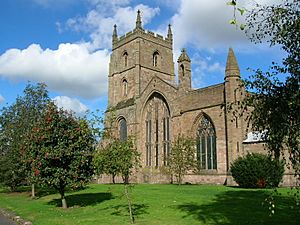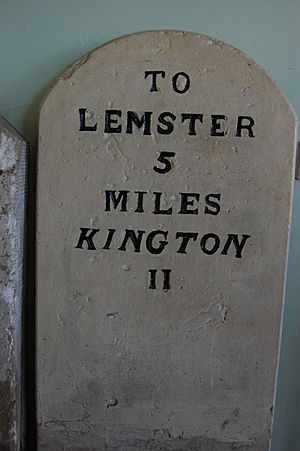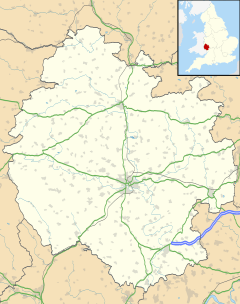Leominster facts for kids
Quick facts for kids Leominster |
|
|---|---|
 Leominster Priory |
|
| Population | 11,959 (2021 Census) |
| OS grid reference | SO496591 |
| Civil parish |
|
| Unitary authority | |
| Ceremonial county | |
| Region | |
| Country | England |
| Sovereign state | United Kingdom |
| Post town | LEOMINSTER |
| Postcode district | HR6 |
| Dialling code | 01568 |
| Police | West Mercia |
| Fire | Hereford and Worcester |
| Ambulance | West Midlands |
| EU Parliament | West Midlands |
| UK Parliament |
|
Leominster (pronounced LEM-stər) is a busy market town in Herefordshire, England. It sits where two rivers meet: the River Lugg and the River Kenwater.
The town is about 12 miles (19 km) north of Hereford. It is also 7 miles (11 km) south of Ludlow in Shropshire. With nearly 12,000 people, Leominster is the biggest town in Herefordshire. The other towns in the county are Ross-on-Wye, Ledbury, Bromyard, and Kington.
From 1974 to 1996, Leominster was an important local government center.
Contents
What's in a Name?
The name Leominster comes from two old words. 'Minster' means a place where a group of clergy (religious leaders) lived. The other part, 'Leon' or 'Lene', was an old Celtic name for the area. It likely came from an Old Welsh word meaning 'to flow', perhaps referring to the rivers.
The Welsh name for Leominster is Llanllieni. The word 'Llan' often means a church or religious community. This suggests that Leominster had a Christian community a very long time ago.
A Look Back in Time
Early History and Viking Raids

In the early Middle Ages, Leominster was home to a saint named Æthelmod. He was an English saint, and people believe he is buried in Leominster.
During the 700s and 800s, Vikings often attacked this area. In 2015, a large collection of treasures was found near Leominster. This collection, called the Herefordshire hoard, included Saxon jewelry, silver, and coins. Experts think a Viking buried it around 879 AD during their raids. At that time, Alfred the Great ruled Wessex, and Ceolwulf II of Mercia ruled Mercia.
In 1052, a Welsh leader named Gruffudd ap Llywelyn raided Leominster. This led to a battle called the Battle of Llanllieni. Welsh forces fought against a combined group of Normans and English Saxons.
The Priory and Its Story
King Henry I gave the minster and its lands to Reading Abbey. This abbey then started a priory (a type of monastery) in Leominster in 1121. However, there was a religious community here even earlier, in Saxon times.
Today, the Priory Church of St. Peter and St. Paul is the main church for the town. It is the part that remains from the old 12th-century Benedictine monastery.
In 1402, Welsh forces led by Owain Glyndŵr attacked the priory. This happened after their victory at the Battle of Bryn Glas.
In 2005, archaeologists found the location of the priory's cloister (a covered walkway). They also found old animal bones. These bones showed that people lived in this area as early as the 600s. This fits with the story that a monk named St. Eadfrith started a Christian community here around 660 AD.
Wool and Industry
Leominster is famous for being the home of Ryeland sheep. These sheep were known for their amazing wool, which people called 'Lemster ore'. This wool was very valuable. It was traded with countries in Europe during the Middle Ages. The money from this wool trade helped the town and the minster grow.
Later, in the mid-1700s, Pinsley Mill in Leominster became home to one of the world's first four cotton mills. These mills used new spinning machines invented by Lewis Paul and John Wyatt. This mill was very successful. People admired the cotton works there.
A Strange Punishment
One of the last times a ducking stool was used in England happened in Leominster in 1809. A woman named Jenny Pipes was the last person to be punished this way. A ducking stool was a chair used to dunk people into water as a punishment. You can see the ducking stool on display in Leominster Priory. A moving model of it is also on the town clock.
Weather in Leominster
Leominster has a mild climate, meaning winters are not too cold and summers are not too hot. The information below comes from a weather station near Leominster.
| Climate data for Shobdon Airfield, (1991–2020 normals, extremes 1992–present) | |||||||||||||
|---|---|---|---|---|---|---|---|---|---|---|---|---|---|
| Month | Jan | Feb | Mar | Apr | May | Jun | Jul | Aug | Sep | Oct | Nov | Dec | Year |
| Record high °C (°F) | 14.9 (58.8) |
17.2 (63.0) |
22.3 (72.1) |
24.6 (76.3) |
26.6 (79.9) |
30.8 (87.4) |
35.0 (95.0) |
33.1 (91.6) |
29.5 (85.1) |
27.2 (81.0) |
18.0 (64.4) |
15.2 (59.4) |
35.0 (95.0) |
| Mean daily maximum °C (°F) | 7.6 (45.7) |
8.2 (46.8) |
10.6 (51.1) |
13.5 (56.3) |
16.7 (62.1) |
19.6 (67.3) |
21.7 (71.1) |
21.3 (70.3) |
18.6 (65.5) |
14.4 (57.9) |
10.5 (50.9) |
7.9 (46.2) |
14.3 (57.7) |
| Daily mean °C (°F) | 4.5 (40.1) |
4.9 (40.8) |
6.6 (43.9) |
8.8 (47.8) |
11.7 (53.1) |
14.5 (58.1) |
16.4 (61.5) |
16.2 (61.2) |
13.8 (56.8) |
10.5 (50.9) |
7.0 (44.6) |
4.7 (40.5) |
10.0 (49.9) |
| Mean daily minimum °C (°F) | 1.3 (34.3) |
1.5 (34.7) |
2.5 (36.5) |
4.1 (39.4) |
6.7 (44.1) |
9.4 (48.9) |
11.1 (52.0) |
11.0 (51.8) |
8.9 (48.0) |
6.6 (43.9) |
3.5 (38.3) |
1.4 (34.5) |
5.7 (42.3) |
| Record low °C (°F) | −12.2 (10.0) |
−9.5 (14.9) |
−7.8 (18.0) |
−4.9 (23.2) |
−2.3 (27.9) |
0.2 (32.4) |
2.6 (36.7) |
2.4 (36.3) |
−0.7 (30.7) |
−5.6 (21.9) |
−9.5 (14.9) |
−16.9 (1.6) |
−16.9 (1.6) |
| Average precipitation mm (inches) | 77.2 (3.04) |
60.1 (2.37) |
55.5 (2.19) |
58.6 (2.31) |
56.4 (2.22) |
58.3 (2.30) |
55.6 (2.19) |
64.2 (2.53) |
58.8 (2.31) |
84.5 (3.33) |
81.9 (3.22) |
86.4 (3.40) |
797.3 (31.39) |
| Average precipitation days (≥ 1.0 mm) | 13.9 | 11.0 | 10.5 | 10.1 | 10.0 | 9.3 | 9.2 | 10.2 | 9.4 | 12.2 | 13.4 | 13.7 | 132.9 |
| Mean monthly sunshine hours | 55.0 | 83.9 | 118.9 | 165.7 | 213.5 | 195.1 | 214.9 | 168.1 | 149.1 | 103.4 | 68.6 | 56.3 | 1,592.4 |
| Source 1: Met Office | |||||||||||||
| Source 2: Starlings Roost Weather | |||||||||||||
Getting Around Leominster
Train Travel
Leominster railway station is run by Transport for Wales. Trains travel along the Welsh Marches Line. You can catch direct trains to places like Cardiff, Hereford, Ludlow, Shrewsbury, Crewe, and Manchester.
Bus Services
The town has a bus station, which is the main place for bus services. Buses are run by Lugg Valley Travel and First Worcester. They connect Leominster to Hereford, Ludlow, and Ledbury.
Roads
Leominster is an important meeting point for major roads in Great Britain. The A49 road (running north-south) and the A44 road (running east-west) meet here. From Leominster, you can find signs for roads leading to Rhayader, Worcester, Shrewsbury, and Hereford.
Schools in Leominster
Earl Mortimer College is a state school for secondary education. About 650 students attend this school. It used to be known as the Minster school.
There is also Leominster Primary School and Westfield's Special School. Other primary schools are in nearby villages like Ivington, Kimbolton, Kingsland, Luston, and Stoke Prior.
Local Media
For news in print, Leominster has the Hereford Times, The Leominster News, and the Teme Valley Times.
Local TV news comes from BBC West Midlands and ITV Central. You can get TV signals from the Ridge Hill TV transmitter.
Local radio stations include Sunshine Radio, Sunshine 855, BBC Hereford & Worcester, Hits Radio Herefordshire & Worcestershire, and Greatest Hits Radio Herefordshire & Worcestershire.
Famous People from Leominster
- Saint Cuthfleda was a leader at the Leominster nunnery. She was known for her holy and pure life.
- Æthelmod of Leominster was an Anglo-Saxon saint.
- Leofric, Earl of Mercia and his wife Lady Godiva are remembered for helping the monastery in Leominster.
- John Abel (1578/9–1675) was a famous English carpenter. He was known as the 'King's Carpenter'. He built many beautiful timber-framed buildings. One of his best works is Grange Court (1633) in Leominster.
- John Ward (1704–1773) was an English actor and theatre manager.
- John Scarlett Davis (1804–1845) was an artist born in Leominster. Some of his paintings are in Leominster Museum.
- Arthur Peppercorn (1889–1951) was a designer of locomotives (train engines).
- Jarrod Bowen (born 1996) is a footballer who plays for West Ham United and the England national football team.
Twin Towns
Leominster is twinned with two other towns:
- Saverne in eastern France
- Tengeru in Tanzania
Places to Visit
See also
 In Spanish: Leominster para niños
In Spanish: Leominster para niños



